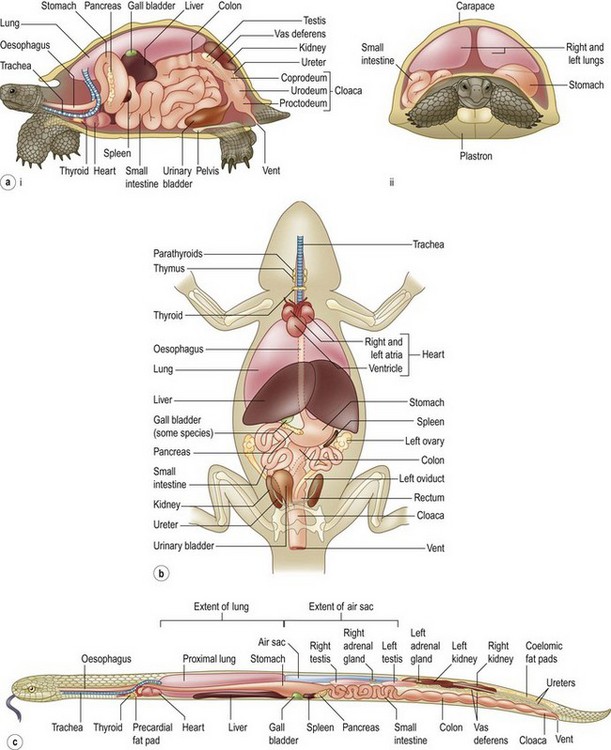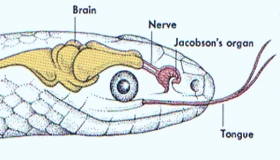Reptiles: Structure and Function Study Guide
Introduction:
Internal fertilization, amniotic development, and epidermal scales covering part or all of their bodies characterize reptiles. They are air-breathing vertebrates that have certain special features that make them different from the other classes.
General characteristics of Reptiles:
- Tetrapod animals that generate amniotic eggs are known as reptiles.
- Crocodiles, alligators, lizards, snakes, and turtles are among them.
- The reptile family is one of the most diverse groups of vertebrates.
- Except for birds and mammals, it includes all amniotes.
General Anatomy
- Amphibians lack numerous adaptations that reptiles have for surviving on dry land.
- Most reptiles, for example, have scales on their skin. Reptiles’ scales, formed of very durable keratin, protect them from harm and keep them from losing water.
General anatomy includes a body divided into head, neck, trunk, tail.
-
A three-chamber heart with two atria and one partly split ventricle is seen in most reptiles. Blood flow may be changed to pump deoxygenated blood to the body or prohibit it from reaching the lungs. Because pumping blood to the lungs consumes energy, redirecting blood flow can save the reptile energy when it is not active or allow aquatic animals to dive for longer periods.
-
A three-chambered heart is not seen in all reptiles. Crocodilians, for example, have a four-chambered heart, similar to mammals and birds. However, during dives, its four-chambered heart may function as a three-chamber heart. In addition, it has been revealed that some snake and lizard species have three-chambered hearts that may compress into four-chambered hearts.
-
Reptiles use behavioral adaptations to regulate their body temperature; they manage their body temperature by shifting their daily position.
-
All reptiles use lungs for breathing. The surface area of the reptile lung for gas exchange is substantially larger than that of the amphibian lung. The lungs of many reptiles feature small sacs called alveoli through which gas is transferred.
-
The “buccal pump” approach involves taking in the air via the nose and moving the floor of the mouth or throat up and down in a way that makes the animal appear to be gulping air. When the lizard’s mouth is full of air, it will force it down into its lungs.
-
Following that, the nostrils are closed, the glottis is opened, and the floor of the mouth is lifted, pushing air into the lungs for gas exchange. The process is reversed to deflate the lungs. On the other hand, Mammals use their thoracic diaphragm to expand and deflate their lungs actively.
-
Crocodiles have a muscular diaphragm that is comparable to the diaphragm of mammals. The distinction in crocodilians is that their diaphragm muscles pull a portion of the pelvis back, lowering the liver and allowing the lungs to expand.
-
Most reptiles, unlike other vertebrates, lack a secondary palate, which separates the nasal cavity from the mouth cavity.
-
Two tiny kidneys are in charge of excretion. Uric acid is the major nitrogen-containing waste product of crocodilians, snakes, lizards, and tuatara. Turtles, like mammals, emit urea mostly. Unlike those of mammals and birds, Reptile kidneys are unable to generate urine that is more concentrated than their bodily fluids. This is due to the absence of the Loop of Henle, a specialized structure found in the nephrons of birds and mammals. As a result, many reptiles employ the colon to help in water absorption.
-
Dermal pressure points: Sensory pits cover crocodilians’ top and lower jaws, which appear as black spots on the skin. Bundles of nerve fibers in these sensory pits detect minuscule vibrations and pressure changes in water. Crocodilians can detect prey, danger, and intruders even in complete darkness because of their sensors.
-
Jacobson’s organ: In the roof of a snake’s mouth, Jacobson’s organ comprises two hollow, very sensitive sac-like organs. The snake may “smell” its environment by putting chemicals collected on the tip of its tongue into the organ. Snakes may smell with just their nose or using their Jacobson’s organ as well.
Conclusion:
- A three-chamber heart with two atria and one partly split ventricle is seen in most reptiles.
- Reptiles use behavioral adaptations to regulate their body temperature; they manage their body temperature by shifting their daily position.
- The respiratory system of reptiles consists of the lungs.
- Most reptiles, unlike other vertebrates, lack a secondary palate, which separates the nasal cavity from the mouth cavity.
- Two tiny kidneys are in charge of excretion.
FAQs:
1. What is the structure of a reptile?
Characteristics in general. Most reptiles have a continuous layer of epidermal scales on their skin. Reptile scales include a unique kind of keratin termed beta keratin and alpha keratin, which is found in other vertebrates’ scales and interscalar skin. The major component of reptile scales is keratin. General anatomy includes the body divided into head, neck, trunk, tail.
2. What is the function of reptile skin?
Amphibians lack numerous adaptations that reptiles have for surviving on dry land. Most reptiles, for example, have scales on their skin. Reptiles’ scales, formed of very hard keratin, protect them from harm and keep them from losing water.
3. What are the 7 main characteristics of reptiles?
- Dry skin with scales but no feathers (as in birds) or hair (as in mammals)
- Internal fertilisation
- A three- or four-chambered heart
- Cold-bloodedness
- The presence of lungs
- Direct development, without larval forms as in amphibians
- An amniote egg
4. What are the main features of reptiles?
- These are terrestrial creatures with scales on their bodies that crawl and burrow.
- They are cold-blooded creatures found in most of the world’s warmer climates.
- Their skin is dry, rough, and lacks glands.
- The head, neck, trunk, and tail are the four parts of the body.
5. What are 3 facts about reptiles?
- Most reptiles are cold-blooded animals.
- Crocodiles are known for sweating through their mouths.
- Not all reptiles lay shelled eggs, although the majority do.
6. What is the importance of reptiles?
- In most ecosystems, reptiles play a significant role in the food chain.
- Reptiles have a crucial role as predators and prey.
- Herbivores play a crucial role in seed dispersal, and some even serve as pollinators.
- In ecosystems, reptile species can also play a valuable anthropogenic function.
- Reptiles can assist in managing agricultural pests such as insects and rodents in particular areas.
- Many people eat reptiles as a source of protein.
We hope you enjoyed studying this lesson and learned something cool about Reptiles: Structure and Function! Join our Discord community to get any questions you may have answered and to engage with other students just like you! Don’t forget to download our App and check out our awesome VR classrooms- we promise, it makes studying much more fun!😎
Sources:
- Reptiles. https://flexbooks.ck12.org/studyguides/biology/reptiles-study-guide.html?encodedID=SCI.BIO.827&courseContextID=5292077. Accessed 3 Dec 2021.
- Reptiles. https://kids.nationalgeographic.com/animals/reptiles. Accessed 3 Dec, 2021.
- Reptiles. https://www.nwf.org/Educational-Resources/Wildlife-Guide/Reptiles. Accessed 3 Dec, 2021.
- Reptile. https://www.britannica.com/animal/reptile. Accessed 3 Dec, 2021.


